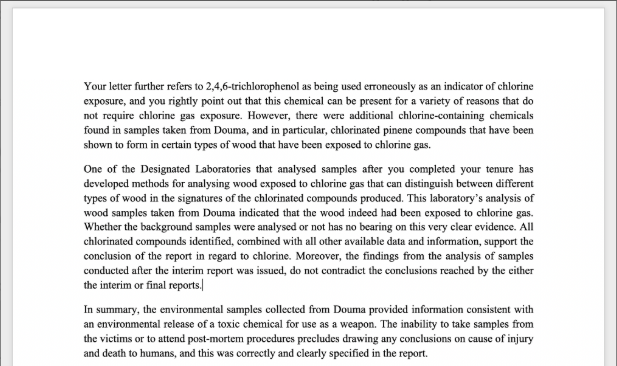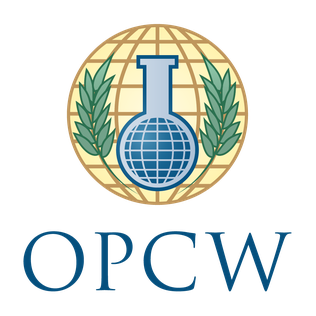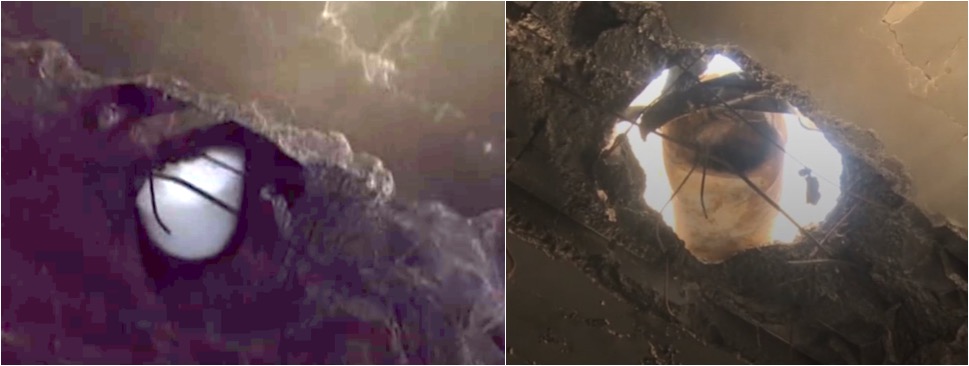Revisiting Syria's 2013 Sarin Attack on Saraqeb, Idlib
In May 2013 Bellingcat’s predecessor, the Brown Moses Blog, published an analysis of the April 29th 2013 chemical attack on the town of Saraqeb, Idlib. In light of information recently published by the French government about the attack this post revisits the earlier analysis with updated information.
Summary of events in Saraqeb
The following summary of events is mainly based on open source information, reports by Ian Pannell, who visited Saraqeb in mid-May 2013, and information released by the French government on April 26th 2017.
Shortly after midday April 29th the town of Saraqeb was attacked from government position, reportedly 8km away. A unknown number of projectiles hit the town, possibly artillery rounds or rockets.
A helicopter was spotted high above the town, with three objects dropped from the helicopter as it travelled across the town. The objects left a smoke trail as they fell through the sky.
The objects landed in the garden of Mariam Khatib, a dirt track, and outside the town by the side of a road. Mariam Khatib’s family was affected by the gas when they went to investigate the objects, as well as opposition fighters who went to assist them.
The objects themselves appear to have been different designs of grenades placed inside a cinder-block and/or box.
Witnesses claim that shortly after the objects landed casualties began to arrive at Saraqeb hospital.
Doctors told the BBC eight people were admitted, some of whom had been driven to the hospital by car. The 2017 French report states 20 people were injured, and one killed.
The victims were later taken to the hospital in Reyhanli, Turkey, where one victim, Mariam Khatib, died. Reports claims that between 11 and 13 victims were taken to the Reyhanli hosptial, with no further details given. Samples from the scene were reportedly taken to Britain, France, Turkey and America for testing.Reports in May 2013 would state Turkish doctors found no presence of sarin gas in the victims blood samples, but a later December 2013 UN report would state the autopsy of the only fatality of the Saraqeb attack “clearly indicated signatures of a previous Sarin exposure”. The presence of sarin in biomedical samples was also confirmed in the 2017 French report.
The 2017 French report would also include analysis of one of the grenades that didn’t explode, including a chemical analysis of the contents of the grenade which included “a solid and liquid mix of approximately 100ml of sarin at an estimated purity of 60%. Hexamine, DF and a secondary product, DIMP.”
Devices used in the attack
Eyewitnesses told the BBC at least two devices were dropped from a helicopter, producing trails of smoke, with video of one of the devices appearing to show it was burning as it fell (1:18)
The 2017 French report describes this as follows:
That mid-afternoon, a helicopter arriving from the north-east flew over the city of Saraqib at high altitude. Three unidentified objects, emitting white smoke, were dropped on neighbourhoods to the west of the city, on a north-south trajectory.
The report also includes a map showing the impact sites and path of the helicopter:
One device landed on the outskirts of Saraqeb, with “eyewitnesses describing a box-like container with a hollow concrete casing inside”, likely a cinder-block:
In the video civilians seem unconcerned about coming very close to the impact site, but according to the 2017 French report an unexploded device was recovered from this impact site, suggesting the munition did not release any chemical agent.
The smell at the scene of the attack is described to the BBC as being very strong:
“It was a horrible, suffocating smell. You couldn’t breathe at all. Your body would become really tired.”
In this video it’s stated “These are smelly, and a lot of them were used.”.
Witnesses claimed inside each package dropped from the helicopter there were two canisters, with one of the recovered canister shown in two videos. Firstly this video (0-30s)
Then this example of the same canister, inside a large jar:
The canister is also featured in this photograph:
You’ll note 4 holes with black marks around them on the body of the canister, which may relates to the burning seen in the video of one of the canisters being dropped.
This canisters match devices recovered from a scene of a earlier attack in Sheikh Maghsoud on April 13th 2014 (details here), which shared a number of other similarities with the Saraqeb attack. Photographs from the scene of the attack shows greyish-white powder covering the area, possibly the remains of a cinder-block, for example:
Mohammed Aly Sergie reported some details of the Sheikh Maghsoud attack provided by witnesses:
Canisters with a phosphorous type chemical, causing Sarin-like symptoms, were dropped on a home in Sheikh Maqsood on April 13 around 2 a.m.
— Mohammed Aly Sergie (@msergie) April 14, 2013
Some survivors said the canisters were dropped from a helicopter, but others didn't hear rotors. Doctors don't know what the chemicals were
— Mohammed Aly Sergie (@msergie) April 14, 2013
Two children died in the attack, and their mother died later on the way to a hospital in Atme, Idlib. More than a dozen people were exposed
— Mohammed Aly Sergie (@msergie) April 14, 2013
Survivors from Sheikh Maqsood all gave the same story today. Syria’s war is tiptoeing into the chemicals weapons phase.
— Mohammed Aly Sergie (@msergie) April 14, 2013
“Phosphorous type chemical” would suggest either smoke or burning, as seen in the Saraqeb attack. There’s also reports of the device being dropped from a helicopter, with a small number of casualties.
This photograph from the Sheikh Maghsoud attack shows the upper body of two of the canisters from the Sheikh Maghsoud:
Both have had what’s known as a “fly-off lever” reattached to them. A fly-off lever is what you see on a hand grenade, and it is released when a ring pull is removed, which then allows the lever to rotate over the top of the device due to a spring load, releasing a securing pin that renders the device live (more details here). The fly-off lever may or may not detach, and in this example it appears they have, as they’ve been put back on the upper body of the canister backwards. This indicates the canisters are in fact some form of grenade.
Another interesting point is that while the upper body on the left is a match to what we’ve seen in Saraqeb the upper body on the right appears to be a different design.
There’s one more piece of evidence that points to these items being some kind of grenade. This photograph, taken by Jeffry Ruigendijk, shows a Jabhat al-Nusra fighter carrying one of the weapons in question:
A close up of the grenade shows the finer details:
This matches what has been seen in Saraqeb and Sheikh Maghsoud almost perfectly, the only details that are different is that the fly-off lever appears to be black (although that might just be the reflection of his attire), and the presence of the ring pull.
The 2017 French report also provides images of the remains of grenades recovered from the scene. The first image is of a grenade recovered from the second impact site, the courtyard of a home where multiple victims were affected:
The image in the French report is low resolution, but it clearly does not match the white grenade shown above. A third grenade was recovered at the third impact point, close to a main road on the southwest side of the town, where no victims were reported:
This grenade does not appear to match the other two types of grenades. It it also noteworthy witnesses had referred to two canisters in each package dropped from the helicopter in the BBC report on the attack, but the French report only talks about two grenades from two different sites, and does not refer to the white grenade shown above. In the Sheikh Maghsoud attack the remains of two grenades were recovered, seemingly from one impact site, suggesting that in that attack the two grenades were dropped together, as described by witnesses in the BBC report.
In the 2017 French report the third, unexploded, grenade was tested, and shown to contain sarin:
The chemical analyses carried out showed that it contained a solid and liquid mix of approximately 100ml of sarin at an estimated purity of 60%. Hexamine, DF and a secondary product, DIMP, were also identified. Modelling, on the basis of the crater’s characteristics, confirmed with a very high level of confidence that it was dropped from the air.
Victims of the attack
There appears to be some confusion over the number of victims, with the BBC being told by doctors there were 8 victims; two women, one child, and five men, but with later reports that the victims were taken to in Reyhanli, Turkey, claiming up to 13 people were treated:
Medics tested the blood samples — which were taken from some 13 victims of an attack that included white powder in the northern village of Saraqeb on April 29 — at the Reyhanli hospital on the same day, but did not find anything unusual, they said.
The 2017 French report describes “one person was killed and about 20 injured”.
Three videos from Saraqeb showing the victims, shown below, were posted online, as well as video footage from the BBC
Using this video footage it was possible to identify separate victims that were treated in Saraqeb:
Female victim 1
Unknown female. Possibly the wife of Mohammed Khatib, see female victim 2 for more details.
Female victim 2
Mariam Khatib, mother of nine children, three of which were also casualties of the attack. According to the BBC report one of the devices dropped from the helicopter landed in her garden
“A canister was released from a helicopter and Mariam Khatib came running to the courtyard and called her son, Mohammed and told him there was a canister with white smoke coming out of it” says Mariam’s nephew, Maed Barish.
“She immediately became unconscious and fell down, as did Mohammed and his wife. Fighters came to help the family but they were also affected by the smoke.”
The BBC reports Mariam Khatib was the worst affected, with videos showing her unconscious, with dilated pupils, with doctors claiming she had signs of chemical exposure. It appears she is in the background of this clip, with the man in the foreground claiming the following
I was not present then, but the FSA members came here and said that those chemicals were dropped on the southwestern side of the town. The injuries varies from bad to minor. The symptoms include constriction of the pupil, forth around the mouth, complete loss of consciousness as result of (inhaling) the smoke. The smoke was smelly, and the guy who rushed to help the victims lost consciousness when he got to the site.
The BBC also reports Mariam Khatib was taken to a hospital on the border with Turkey
Four patients were taken to a hospital near the border.
Dr Jumaa Samadi, who treated them, says they were all given decontamination showers and atropine to treat their symptoms before being sent to a hospital in Turkey. By the time they arrived, Mariam Khatib was dead.
“The symptoms she displayed – unconsciousness, vomiting, pinpoint pupils – they all correspond to poison gas exposure,” he says.
“They often match organophosphate poisoning. It has many derivatives, one of which is Sarin gas.”
A later December 2013 UN report would state the autopsy of Mariam Khatib “clearly indicated signatures of a previous Sarin exposure.”
Mariam Khatib is the only recorded fatality of this attack.
Female victim 3
Mariam Khatib’s daughter, according to the BBC report. In the footage in the BBC report she appears to have a distended tongue, but in the footage from Youtube it appears that may not be the case, although the angle makes it difficult to be sure.
Male victim 1
This uniformed victim is retching, and spitting out liquid. Possibly one of the opposition members who went to help the Khatib family.
Male victim 2
Unknown identity, no obvious symptoms. The doctor with him in the video explains the symptoms he’s seen, symptoms such as froth around the mouth, convulsions and constriction of the pupil, which he says suggests sarin use.
Male victim 3
Possibly Mohammad Khatib, Mariam Khatib’s son. In one video he’s shown with froth coming from his mouth, and in apparent discomfort, and in two other videos (1, 2), shown with a drip, receiving oxygen. If this is Mohammad Khatib he’s interviewed by the BBC 2:24 into their report:
Today Mohammed lives in a tent outside of town. He says he is too afraid to return to the house, too distraught by what happened there.
Speaking for the first time he says he still feels weak and exhausted.
“It was a horrible, suffocating smell. You couldn’t breathe at all. Your body would become really tired.”
“You’d lose all senses. You’d feel like you were dead. You couldn’t even see. I couldn’t see anything for three or four days.”
Male victim 4
Unknown victim, appears to not have severe symptoms in the video he’s featured in.
Male victim 5
An unknown uniformed male in distress, possibly another of the opposition fighters who went to help the Khatib family. Clearly in great discomfort and retching, at 11s he is uttering the shahadda, and as 43s he’s raising his index finger. The shahadda is often recited when someone expects to die, often with an index finger raised.
Male victim 6
Mariam Khatib’s younger son, featured in the BBC report at 2:07, with the BBC report stating they “apparently suffered respiratory and visual problems, and appear to have constricted pupils.”.
Conclusion
4 years on from the attack on Saraqeb it is now clear that this attack was the deployment of sarin as a chemical weapon by Syrian government forces against a civilian population that pre-dates the August 21st 2013 sarin attack by 4 months. While many questions have now been answered about the attack, one question remains. Why did Syrian forces use sarin in such a bizarre way, with helicopters throwing grenades filled with sarin onto a town in what appears to be boxes holding cinder-blocks? While we can state for certain the 2013 attack on Saraqeb was a sarin attack, we are yet to understand exactly why the attack took place in the manner it did.























